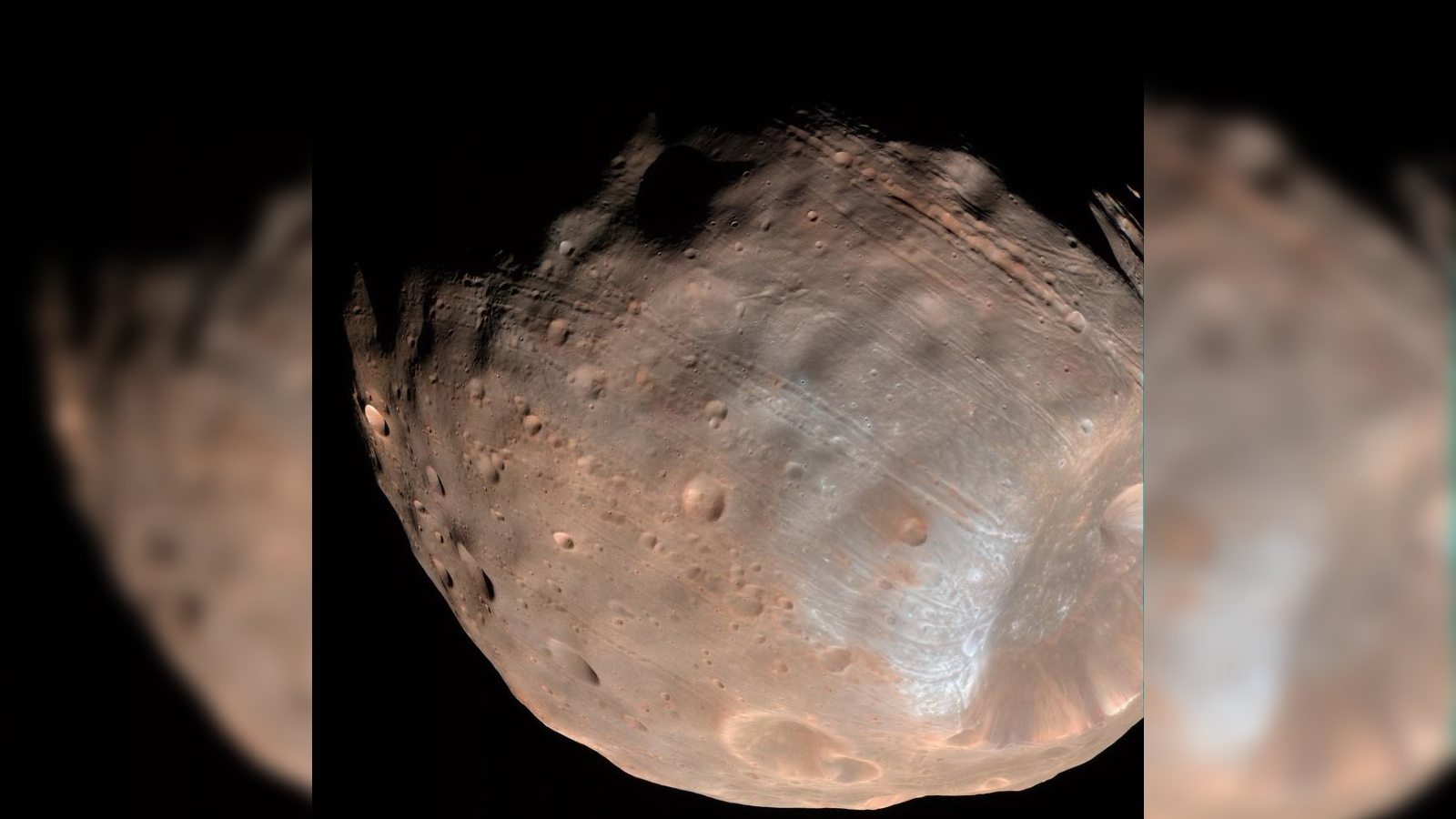Mars may be slowly ripping its largest moon apart
A new study has revealed that the weird parallel grooves on the surface of Mars' largest moon Phobos could be a sign that the Red Planet's gravity is ripping the satellite apart.

Mars' largest moon Phobos shows signs of being ripped apart by the extreme gravitational forces exerted on it by the Red Planet, a new study shows.
Researchers have revealed that the unusual grooves covering Phobos' surface, which were previously assumed to be scars from an ancient asteroid impact, are actually dust-filled canyons that are growing wider as the moon gets stretched out by gravitational forces.
Phobos is around 17 miles (27 kilometers) across at its widest point and orbits Mars at a distance of 3,728 miles (6,000 km), completing a full rotation around the Red Planet three times every day, according to NASA. For comparison, Earth's moon is around 2,159 miles (3,475 km) wide, 238,855 miles (384,400 km) from our planet and takes around 27 days to complete one orbit.
Related: Brand-new mini 'moon' found lurking in the outer solar system
However, unlike the moon, Phobos' orbit around Mars is not stable: The tiny satellite is trapped in a death-spiral and is slowly falling towards the Martian surface at a rate of 6 feet (1.8 meters) every 100 years, according to NASA.
But Phobos' most unusual feature is arguably its mysterious stripey surface. Parallel grooves, or surface striations, cover the moon. The most widely accepted theory suggests that the striations formed when an asteroid slammed into Phobos at some point in the past, which left behind a 6-mile (9.7 km) wide crater, known as Stickney, in the moon's flank.
But a new study, published Nov. 4 in the The Planetary Science Journal, suggests that the grooves may actually be the result of the moon slowly being ripped apart by Mars' intense gravity as Phobos circles ever closer to the planet's surface.
Get the Space.com Newsletter
Breaking space news, the latest updates on rocket launches, skywatching events and more!
The idea behind the new study is that as one body, in this case Phobos, gets closer to a larger body, such as Mars, the smaller will begin to stretch out in a line towards the larger body. This is known as tidal force.
In the case of Phobos, the tidal force exerted on the moon is predicted to increase as Phobos gets closer to the Martian surface, until finally the tidal force becomes greater than the gravity holding the satellite together. At that point, Phobos will be completely ripped apart and the debris will likely form a tiny ring around the planet, like the rings of Saturn, according to the study.
While prior research suggested tidal forces produced Phobos' tiger stripes the theory has been largely dismissed due to the moon’s powdery or “fluffy” composition, making it too soft for such cracks to form.

In the new study, researchers used computer simulations to test the idea that the moon's fluffy surface may rest atop a somewhat cohesive sub-layer. A buried hard shell could potentially have formed deep canyons that the surface dust could fall into, creating the grooves visible on the surface, the simulation found.
"Modeling Phobos as a rubble-pile interior overlaid by a cohesive layer, we find that the tidal strain could create parallel fissures with regular spacing," the researchers wrote in the paper.
At its current rate, Phobos will complete its death spiral and hit Mars in around 40 million years. But if tidal forces are already tearing the moon apart, then the satellite could be completely destroyed long before then, researchers wrote.
In 2024, the Japanese Space Agency, JAXA, will launch a new mission, known as Martian Moons eXploration (MMX), to land a spacecraft on both Phobos and Deimos. The samples returned in 2029 should reveal what's going on with Phobos' stripey surface.
Join our Space Forums to keep talking space on the latest missions, night sky and more! And if you have a news tip, correction or comment, let us know at: community@space.com.

Harry is a U.K.-based staff writer at Live Science. He studied Marine Biology at the University of Exeter (Penryn campus) and after graduating started his own blog site "Marine Madness," which he continues to run with other ocean enthusiasts. He is also interested in evolution, climate change, robots, space exploration, environmental conservation and anything that's been fossilized. When not at work he can be found watching sci-fi films, playing old Pokemon games or running (probably slower than he'd like).










